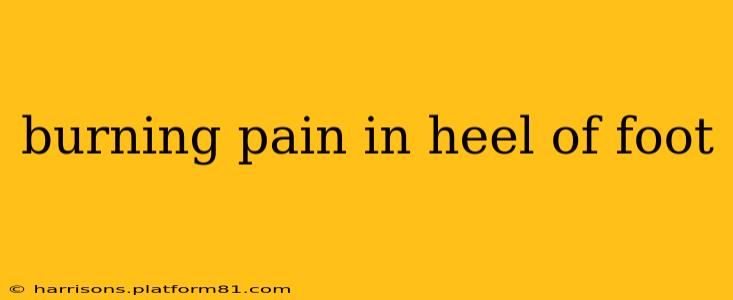Experiencing a burning pain in the heel of your foot can be incredibly debilitating, interfering with daily activities and causing significant discomfort. This isn't simply a minor ache; a burning sensation often points to underlying issues requiring attention. This comprehensive guide explores the potential causes, diagnostic methods, and effective treatment options for this persistent problem. Understanding the root cause is crucial for finding lasting relief.
What Causes Burning Heel Pain?
Several factors can contribute to a burning sensation in your heel. Pinpointing the exact cause requires a thorough examination by a medical professional, but common culprits include:
-
Plantar Fasciitis: This is arguably the most frequent cause of heel pain. The plantar fascia, a thick band of tissue running along the bottom of your foot, becomes inflamed, leading to sharp, stabbing pain, often worse in the morning or after periods of rest. The pain can radiate across the heel, sometimes including a burning sensation.
-
Heel Spur: A bony growth (spur) on the heel bone can irritate the plantar fascia, contributing to plantar fasciitis and the associated burning pain. While the spur itself might not directly cause the burning, it exacerbates the inflammation.
-
Nerve Compression (Tarsal Tunnel Syndrome): The tibial nerve runs through a tunnel in your ankle. If this nerve becomes compressed or irritated, it can cause burning, tingling, or numbness, not just in the heel but also down the arch and into the toes.
-
Achilles Tendinitis: While often associated with pain higher up in the back of the heel, Achilles tendinitis can sometimes manifest with referred pain that feels like a burning sensation in the heel itself.
-
Stress Fractures: Repeated stress on the heel bone can lead to tiny cracks. This can cause pain that feels sharp and burning, particularly during weight-bearing activities.
-
Bursitis: Inflammation of the bursae (small, fluid-filled sacs that cushion the heel bone) can cause pain that resembles a burning sensation.
-
Sever's Disease (in children and adolescents): This involves inflammation of the growth plate in the heel bone. It's commonly characterized by heel pain, often described as burning.
-
Other inflammatory conditions: Conditions like rheumatoid arthritis can also lead to inflammation in the heel, resulting in burning pain.
-
Diabetes: People with diabetes can develop nerve damage (peripheral neuropathy) that leads to burning sensations in their feet and heels.
How is Burning Heel Pain Diagnosed?
Your doctor will start by taking a detailed medical history and performing a physical examination to assess your range of motion, palpate the affected area, and identify any tenderness or swelling. They might employ additional diagnostic tools, including:
- X-rays: To rule out bone spurs, fractures, or other skeletal abnormalities.
- Ultrasound: To visualize soft tissues, such as the plantar fascia and tendons.
- MRI or CT scans: In more complex cases, these can offer detailed images of the heel and surrounding structures.
- Nerve conduction studies: To evaluate for nerve compression (like tarsal tunnel syndrome).
What are the Treatment Options for Burning Heel Pain?
Treatment depends largely on the underlying cause and severity of the pain. Common approaches include:
-
Rest and Ice: Reducing stress on the heel by resting and applying ice packs can help manage inflammation.
-
Over-the-Counter Pain Relief: Nonsteroidal anti-inflammatory drugs (NSAIDs) like ibuprofen or naproxen can reduce pain and inflammation.
-
Physical Therapy: A physical therapist can design a personalized exercise program to strengthen the foot and ankle muscles, stretch the plantar fascia, and improve flexibility. They may also use modalities such as ultrasound or electrical stimulation.
-
Orthotics: Custom-made or over-the-counter arch supports can help to redistribute pressure and reduce strain on the plantar fascia.
-
Night Splints: These devices hold the foot in a slightly flexed position overnight, helping to stretch the plantar fascia and reduce morning stiffness.
-
Injections: Corticosteroid injections can be used to reduce inflammation in severe cases, but these are not a long-term solution.
-
Surgery: Surgery is usually a last resort and is considered only when conservative treatments fail to provide relief.
What are the Home Remedies for Burning Heel Pain?
While professional medical advice is crucial, several home remedies can provide temporary relief and support treatment:
- Rest: Avoid activities that aggravate the pain.
- Ice: Apply ice packs for 15-20 minutes at a time, several times a day.
- Elevation: Keep your feet elevated when possible to reduce swelling.
- Stretching: Gentle stretches can help improve flexibility and reduce plantar fascia tightness.
- Massage: Gently massaging the affected area can help relieve tension and pain.
How Long Does Burning Heel Pain Last?
The duration of heel pain varies depending on the cause and the effectiveness of treatment. Mild cases of plantar fasciitis may resolve within a few weeks, while more severe cases or other underlying conditions could take several months or longer to heal completely. Consistent treatment and adherence to your healthcare provider’s recommendations are vital.
Can Burning Heel Pain Be Prevented?
While not all causes of burning heel pain are preventable, several steps can significantly reduce your risk:
- Maintaining a healthy weight: Excess weight puts extra strain on your feet.
- Wearing supportive footwear: Shoes with good arch support and cushioning can help protect your feet.
- Stretching regularly: Regular stretching exercises can help keep your plantar fascia flexible and prevent tightness.
- Proper warm-up before exercise: Warming up your muscles before physical activity can help reduce the risk of injury.
This information is for general knowledge and doesn't replace professional medical advice. If you're experiencing persistent burning pain in your heel, consult a doctor or podiatrist for a proper diagnosis and treatment plan. Early intervention is key to preventing long-term complications.
